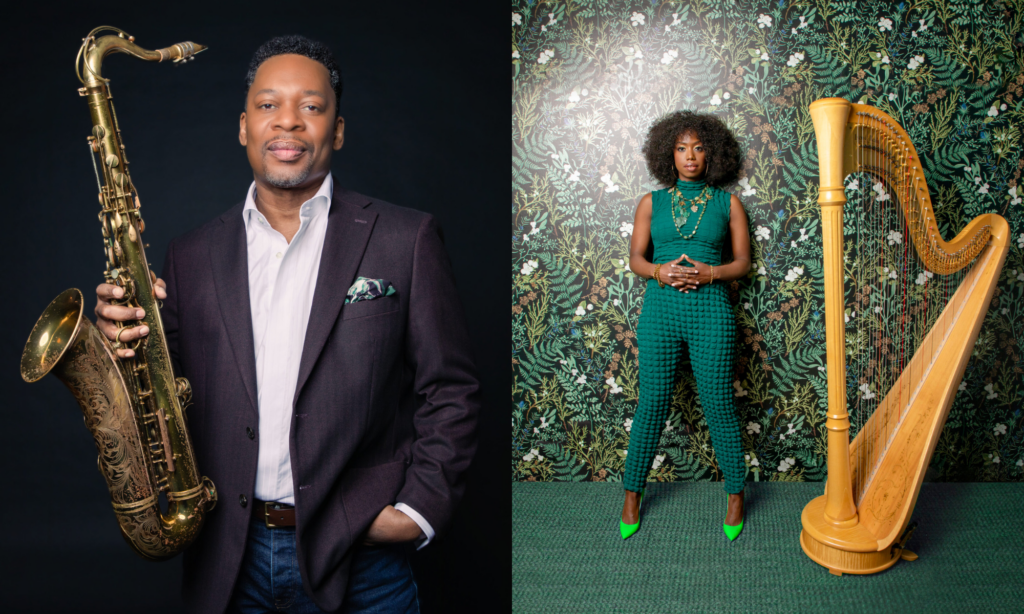
The Egg Presents: TRANSLINEAR LIGHT – The Music of Alice Coltrane featuring Ravi Coltrane with Special Guest Brandee Younger
Music Saturday, June 7 2025 • 8:00pm •$69.50, $59.50, $49.50, +$5 Day of Show
Part of the Egg's "Last Hurrah" Series
Critically acclaimed saxophonist and composer Ravi Coltrane—the second son of jazz legends Alice and John Coltrane—joins forces with renowned trailblazing harpist Brandee Younger for a special performance honoring Translinear Light, the Music of Alice Coltrane.
RAVI COLTRANE is a critically acclaimed Grammy nominated saxophonist, bandleader, and composer. In the course of a twenty plus year career, Mr. Coltrane has worked as a sideman to many, and recorded noteworthy albums for himself and others.
Ravi has released six albums as a leader. His albums include, “Moving Pictures,” “From The Round Box,” “Mad 6,” “In Flux,” “Blending Times,” and “Spirit Fiction.” He also has collaborated on various albums, including, “Seraphic Light” with Joe Lovano and David Liebman, “In Movement” with Jack DeJohnette and Matthew Garrison, and The Blue Note’s 70th Anniversary recording, “Mosaic: A Celebration of Blue Note.” Additional credits include performances as well as recordings with Elvin Jones, Terence Blanchard, Kenny Baron, Steve Coleman, McCoy Tyner, Jack DeJohnette, Matt Garrison, Jeff ‘Tain’ Watts, Geri Allen, Joanne Brackeem, The Blue Note 7, among others.
Born in Long Island, the second son of John Coltrane and Alice Coltrane, Ravi was named after Indian sitar legend Ravi Shankar. He was raised in Los Angeles where his family moved after his father’s death in 1967. His mother, Alice Coltrane, was a significant influence on Ravi and it was he who encouraged Alice to return to performance and the recording studio after a long absence. Subsequently, Ravi produced and played on Alice Coltrane’s powerful, ‘Translinear Light’, which was released in 2004.
Ravi lives in Brooklyn, NY and maintains a fast paced touring, recording, composing and performance schedule. He leads the effort to restore the John Coltrane Home in Dix Hills, Long Island www.thecoltranehome.org and presides over important reissues of his parent’s recordings.
BRANDEE YOUNGER is revolutionizing the harps’ role in modern music. Over the past fifteen years, she has worked relentlessly to stretch boundaries and limitations for harpists. In 2022, she made history by becoming the first Black woman to be nominated for a Grammy® Award for Best Instrumental Composition. That same year, she was also nominated for an NAACP Image Award and later, the winner of the 2024 NAACP Image Award in the category of Outstanding Jazz Album for her latest album Brand New Life. Ever-expanding as an artist, she has worked with cultural icons including Common, Lauryn Hill, John Legend, Pharoah Sanders and Christian McBride.
Her original composition “Hortense” was featured in the Netflix Concert-Documentary, Beyoncé: Homecoming and in 2019, Brandee was selected to perform her original music as a featured performer for Quincy Jones and Steve McQueens’ “Soundtrack of America”. Brandee is often noted for standing on the shoulders of the very women who ushered in the harp as a clear and distinct voice in jazz & popular styles – particularly Detroit natives Dorothy Ashby & Alice Coltrane. Her latest album, Brand New Life, builds on her already rich oeuvre, and cements the harp’s place in popular culture. As the title of the album suggests, Brand New Life is about forging new paths–artistic, personal, political, and spiritual. Younger’s music is imbued with a sense of purpose and respect of legacy, creating a larger platform for the harp to reach newer and wider audiences than ever before. In addition to performing and recording, Brandee Younger is on the faculty at New York University, Steinhardt School and The New School College of Performing Arts. Follow: @harpista
“No harpist thus far has been more capable of combining all of the modern harp traditions — from Salzedo, through Dorothy Ashby, through Alice Coltrane — with such strength, grace and commitment.” – The New York Times



